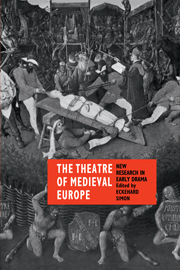Book contents
- Frontmatter
- Contents
- List of contributors
- Preface
- Note on the bibliography and system of references
- List of abbreviations for journals and series
- 1 Introduction: trends in international drama research
- PART I LATIN DRAMA
- PART II ENGLISH DRAMA
- PART III CONTINENTAL DRAMA
- 9 France
- 10 Italy: liturgy and christocentric spirituality
- 11 Spain: Catalan and Castilian drama
- 12 Germany and German-speaking central Europe
- 13 The Low Countries
- Bibliography
- Author index to the bibliography
- General index
10 - Italy: liturgy and christocentric spirituality
Published online by Cambridge University Press: 29 March 2011
- Frontmatter
- Contents
- List of contributors
- Preface
- Note on the bibliography and system of references
- List of abbreviations for journals and series
- 1 Introduction: trends in international drama research
- PART I LATIN DRAMA
- PART II ENGLISH DRAMA
- PART III CONTINENTAL DRAMA
- 9 France
- 10 Italy: liturgy and christocentric spirituality
- 11 Spain: Catalan and Castilian drama
- 12 Germany and German-speaking central Europe
- 13 The Low Countries
- Bibliography
- Author index to the bibliography
- General index
Summary
Although historians of dramatic literature have not accorded to the theatre of medieval Italy a status equal to that assigned to the medieval drama of England, France and Germany, dramatic activity in Italy between the tenth and the fifteenth centuries parallels in length and complexity the development of medieval drama in the various countries of western Europe. The systematic research undertaken, in recent years, into the theatrical history of medieval Italy has raised serious questions about the validity of traditional assumptions and prompted a re-evaluation of its dramatic production, from the liturgical drama to its indigenous vernacular dramatic forms: the lauda and the sacra rappresentazione.
Liturgical drama in Italy is copiously represented by texts dating from the tenth to the fifteenth centuries. The twelfth-century Montecassino Latin drama is the oldest known Passion play and the fourteenth-century Cividale Planctus Mariae ranks among the most remarkable monuments of liturgical drama in Europe. Diffusion is attested by texts originating from Benedictine monasteries, cathedral schools and liturgical centres such as Montecassino, Ivrea, Nanantola, Cremona, Aquileia, Cividale, Parma, Sutri, Padua, Bari, Barletta, Sulmona, Venice, Vercelli and from other locations in Abruzzi and Sicily.
But it is the lauda, a poetico-musical composition originating in liturgical psalmodic singing, that must be looked upon as the matrix of Italian vernacular theatre.
- Type
- Chapter
- Information
- The Theatre of Medieval EuropeNew Research in Early Drama, pp. 169 - 188Publisher: Cambridge University PressPrint publication year: 1991
- 2
- Cited by

